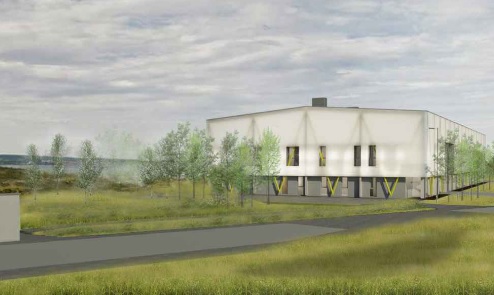Planning permission has been granted for a facility in Inverness to process more than 80,000 tonnes of residual waste to produce refuse derived fuel (RDF).
The facility, which is being developed by Highland council, is to be built on the former Longman landfill site north of the city. It is being built to provide an alternative outlet for the council’s residual waste, which is currently being sent to landfill costing the council around £11 million per year.

Artist’s impression of the facility to be built close to Inverness
This comes ahead of changes to the law in Scotland, that will see biodegradable municipal waste (BMW) banned from landfill from 1 January 2021.
The Highland council, which covers the largest geographic area of any local authority in the UK, collects and disposes of around 144,000 tonnes of waste from households and businesses per-year in towns including Inverness, Fort William and John o’Groats. At present, 43% of this material is recycled or composted.
Several landfill sites are used to handle the council’s residual waste, including the Stoneyhill landfill site in Aberdeenshire, run by Suez, council-owned landfills at Seater and Granish and a further site at Duisky near Fort William. However, this will not be an option for the council post-2021.
It is anticipated that the cost of developing the new facility will be around £6.5 million.
RDF
The council has yet to identify where the finished RDF will be processed, but says that the material will be transported for “use in energy from waste plants elsewhere in Scotland, the UK or Europe”.
Councillor Allan Henderson, chair of the council’s Environment, Development and Infrastructure Committee, said: “The change to national waste regulations from January 1, 2021 will promote consideration of the waste we produce as a valuable resource and is intended to contribute to the development of a more circular economy.
“The Longman facility will play a pivotal role in Highland council’s plans to divert refuse from landfill as well as aiding efficient transportation of our waste and reducing the climate and wider environmental impacts associated with this.”
According to a report put before the council last year, a separate part of the facility will manage the food waste (around 1,500 tonnes) and green waste (15,000 tonnes) generated by Inverness, as well as sorting any recyclable materials found within the household and business waste arriving at the plant.
The 6,000 tonnes of commingled recyclable waste (from blue bins) which currently goes through the Waste Transfer Station at Henderson Road, Inverness operated by commercial operator Suez, would also be channeled through the new MRF.
The facility will comprise of a large rectangular building of approximately 100 metres by 34 metres; office and welfare facilities; a weighbridge and access road.
The post Highland council gets approval for RDF plant appeared first on letsrecycle.com.
Source: letsrecycle.com Waste Managment


